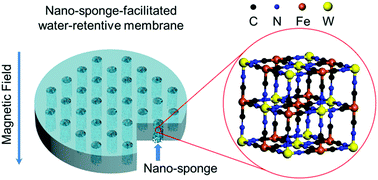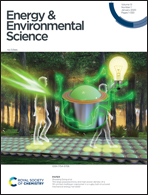Oriented proton-conductive nano-sponge-facilitated polymer electrolyte membranes†
Abstract
Achieving high power output from proton exchange membrane fuel cells (PEMFCs) requires efficient proton transport in proton exchange membranes (PEMs). Since proton conductivity is closely related to membrane moisture content, operation at low relative humidity (RH) and elevated temperature has become a critical bottleneck for the practical application of PEMFCs due to severe PEM dehydration. While several strategies have sought to mitigate this, including external thermal and water management, coating of nano-cracked hydrophobic layers and optimization of membrane intrinsic water retention, only partial improvements have been realized. Here, using a membrane formulation of ferrocyano-coordinated poly(4-vinylpyridine) (CP4VP), phosphotungstic acid (PWA) and polysulfone (PSf), novel highly water-retentive PEMs are fabricated via a strong magnetic field. During magnetic-assisted membrane casting, CP4VP and PWA form a microporous Prussian blue analogue (PBA) framework with the new type of Fe–C![[triple bond, length as m-dash]](https://www.rsc.org/images/entities/char_e002.gif) N–W bonding, which is paramagnetic and is thus simultaneously aligned in the through-plane (TP) direction of the membrane. The neutral PSf membrane component affords mechanical strength to the embedded TP-aligned conducting channels. This new type of microporous PBA framework is highly hydrophilic and proton conductive, with micropores of ∼5.4 Å diameter, which act as nano-sponges to absorb only more retentive non-freezable water, effective for proton conduction. These nano-sponges display efficient water absorption and retention at low RH and elevated temperatures, together with a much faster hydration process than the dehydration process. Furthermore, the TP-aligned PBA channels also enable faster water transport to promote PEM proton conduction beyond any previously reported water-retentive membrane. Consequently, the novel nano-sponge-like PEMs exhibit remarkable performance in both ex situ and in situ evaluations, especially at low RH and elevated temperature, largely prevailing over the commercial benchmark Nafion® 212.
N–W bonding, which is paramagnetic and is thus simultaneously aligned in the through-plane (TP) direction of the membrane. The neutral PSf membrane component affords mechanical strength to the embedded TP-aligned conducting channels. This new type of microporous PBA framework is highly hydrophilic and proton conductive, with micropores of ∼5.4 Å diameter, which act as nano-sponges to absorb only more retentive non-freezable water, effective for proton conduction. These nano-sponges display efficient water absorption and retention at low RH and elevated temperatures, together with a much faster hydration process than the dehydration process. Furthermore, the TP-aligned PBA channels also enable faster water transport to promote PEM proton conduction beyond any previously reported water-retentive membrane. Consequently, the novel nano-sponge-like PEMs exhibit remarkable performance in both ex situ and in situ evaluations, especially at low RH and elevated temperature, largely prevailing over the commercial benchmark Nafion® 212.



 Please wait while we load your content...
Please wait while we load your content...